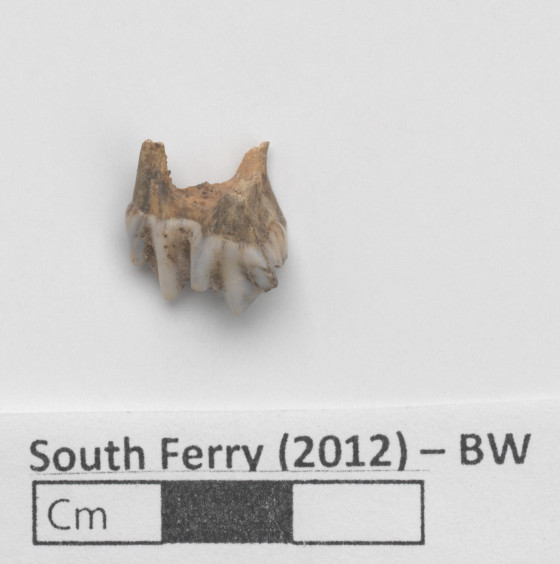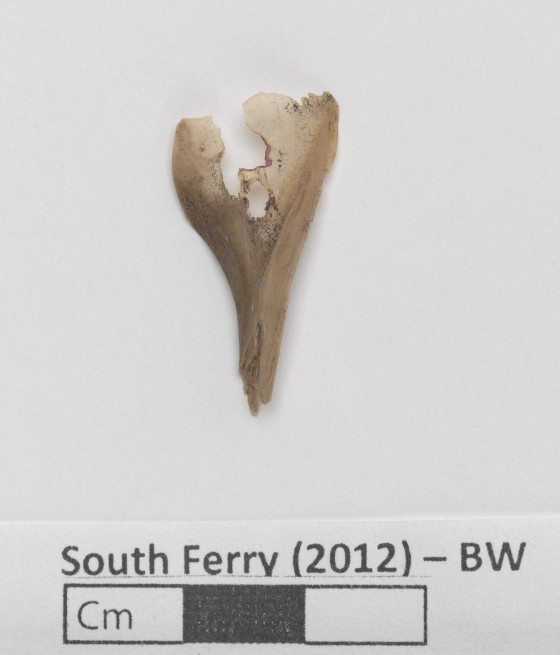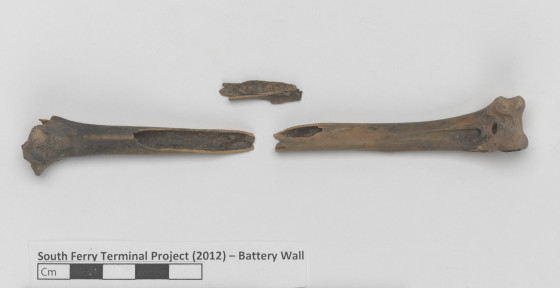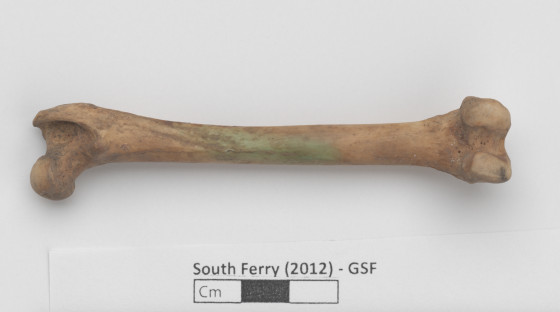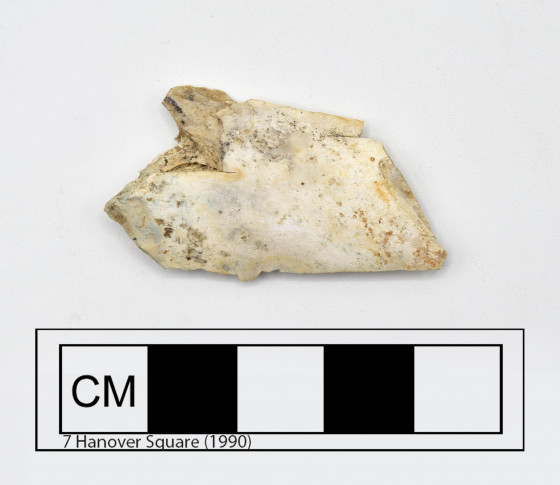Colonial Creatures: Identifying Animal Bones at New York City’s Historical Sites
Guest Curator, Kathryn Sabella
11.29.2017
Animals have played an important role in the lives of New Yorkers for centuries. Like today, people living during the Colonial and Post-Colonial Eras depended on animals for both food and companionship and the remains of these creatures, called faunal material, provide important evidence for historical archaeologists studying the past. Specialists known as zooarchaeologists are responsible for identifying and analyzing the bone, teeth, and shell from archaeological sites to reveal which species were once prevalent, while household faunal refuse deposits provide insight into the daily life of the people who once co-existed with these animals. These contexts can shed light on the diet, socioeconomic status, and ethnicity of the humans from a particular site. Faunal remains also tell the stories of the animals themselves who lived and died in New York City during the 17th-19th Centuries, including their age, sex, injuries or diseases, and cause of death.
After excavating faunal material, archaeologists clean the bones to ensure that their physical characteristics are visible. Faunal analysis depends on the researcher’s ability to recognize subtle differences between classes and species of animals, often based on the size, texture, thickness, weight, and curvature of the bones. Three common classes of animals found at New York City archaeological sites include mammals, birds, and fish. Mammal bones tend to be round with a wood-like exterior, thick walls (known as the cortex), and dense spongy bone (found in between the inner and outer walls) at the ends. Bird bones are generally lightweight and hollow with thinner walls and a naturally smooth exterior. Fish bones often are flat and angular with a glossy finish. Unlike mammal and bird bones, they can appear semi-translucent when held up to a light source.
In addition to identifying the animal class, archaeologists also note the specific bone element that is present (e.g., a femur or rib) and determine if it came from the left or right side of the body. They also may assign a genus and species. Comparative collections found at museums and the New York City Archaeological Repository allow researchers to study bones from identified species and then compare them to fragments of unidentified specimens. Zooarchaeologists also consider functional morphology, the study of organism structure and function, when identifying animal bones. For example, carnivores tend to have sharp, pointed incisors to cut through the flesh of their prey while herbivores have flat molars for grinding down plant material, and mammals that can move at high speeds often have fewer, fused foot bones, which helps them run more efficiently. These kinds of physical clues help researchers narrow down the kinds of animals that may be represented at an archaeological site and determine if populations have changed over time. At certain sites in lower Manhattan such as Stadt Huys and Seven Hanover Square, bones from extinct species like the Passenger Pigeon (Ectopistes migratorius) have been excavated, providing a cautionary tale of the lasting impact that humans can have on their environment.
Identification is just one part of faunal analysis. Bones also contain a wealth of information about their taphonomy, which is the study of everything that happened to an animal from its death until the time of analysis. Worked bone, or bone that was used as a raw material to make artifacts including awls, buttons, and brushes, can reveal what kinds of activities took place at a site, while broken and cut bones are sometimes linked to animals that were butchered for meat or to make products like glue. Butchering technology changed over time and archaeologists may study the appearance of saw marks to identify which tool was used and date a particular context. The presence of butchered animal bones at a domestic site also can indicate what kinds of food people were eating as well as their socioeconomic status. Cooked bones are often burnt and blackened, while those disposed of in a trash fire can appear white and calcined due to prolonged exposure to high heat levels. Additionally, bones can change color when left out to bleach in the sun or buried with other materials, such as copper or iron. Buried bones also may have tiny grooves made by surrounding plants called root etchings, while those left unburied for any period of time can have evidence of gnaw marks from carnivores and rodents looking for nutrients.
Faunal remains also provide information about the lives of the animals who once roamed New York City. Isotopic analyses of the bones can reveal the diet of certain species as well environmental changes. Bones also reflect healed injuries and other pathologies that an animal may have sustained during its lifetime, often appearing as irregular surfaces or bumps. Adult bones can provide clues about an animal’s sex, as certain species exhibit physical differences between males and females. However, it is important to note that there often are exceptions to this rule. Determining age also is a complicated process and varies by species, as some animals grow very quickly while others take many years to reach adulthood. In mammals, archaeologists look at the ends of some bones called epiphyses to estimate age, as these epiphyses grow and eventually fuse with the rest of the bone once an animal reaches maturity. Teeth are another important source of evidence about an animal’s life since enamel preserves far longer than bone. Patterns of dental wear can correspond with age, as can the presence or absence of certain teeth (similar to the eruption of wisdom teeth in humans). Archaeologists also may study layers of a material called cementum in mammal teeth, which is deposited throughout an animal’s life, particularly during the growing seasons of spring and summer. Bands of cementum analyzed under a microscope can reveal the season during which an animal may have been killed or slaughtered.
Faunal bones help tell the stories of New York City’s historical populations of both humans and animals, if you know how to read them. Explore the Repository’s growing online collections to learn more about which bones have been identified thus far.
For further information and citations of the above please see:
“The Archaeology of Colonial New York’s Battery Wall.” MCNY Blog: New York Stories (blog), December 29, 2015.
Beisaw, April M. Identifying and Interpreting Animal Bones: A Manual. College Station: Texas A&M University Press, 2013.
Bone ID, 2016
Gilbert, B. M. Mammalian Osteology. Columbia, Mo: Missouri Archaeological Society, 1990.
Janowitz, Meta F., and Diane Dallal, eds. Tales of Gotham, Historical Archaeology, Ethnohistory and Microhistory of New York City. 2013 edition. New York: Springer, 2013.
Machicek, Michelle, and Smithsonian Institution’s National Museum of Natural History. “Isotope Analysis.” Time Team America: Isotope Analysis, 2013.
Moffitt, Steven A. “Appendix 2: Cementum Annuli Seasonality Analysis of Odocoileus Hemionus Teeth from Ten Sites on the Big Sur Coast.” In Prehistoric Human Ecology of the Big Sur Coast, California, edited by Terri Jones, 277–83. UC Regents, 2003.
Olsen, Stanley J. Fish, Amphibian and Reptile Remains from Archaeological Sites: Part 1, Southeastern and Southwestern United States. Cambridge Mass.: Peabody Museum Press, 2004.
Olsen, Stanley J. Volume 56: Osteology for the Archaeologist: American Mastodon and the Woolly Mammoth; North American Birds: Skulls and Mandibles; North American ... Cambridge, Mass: Peabody Museum Press, 2004.
Reynolds, Joe, "Cod Found Once Again in Cold Ocean Waters off New York Harbor," Atlantic Highlands Herald, March 8, 2017
Root, Waverly, and Richard De Rochemont. Eating in America. Hopewell, NJ: Ecco, 1981.
“SI NMNH Centennial - ‘Martha,’ The Last Passenger Pigeon.” Accessed August 3, 2017.
University of Michigan Museum of Zoology. “Animal Diversity Web,” 2014.
